From the Publisher: “A young, queer Palestinian American woman pieces together her great-aunt’s secrets in this sweeping debut, confronting questions of sexual identity, exile, and lineage.
In a Pacific Northwest hospital far from the Rummani family’s ancestral home in Palestine, the heart of a stillborn baby begins to beat and her skin turns vibrantly, permanently cobalt blue. On the same day, the Rummanis’ centuries-old soap factory in Nablus is destroyed in an air strike. The family matriarch and keeper of their lore, Aunt Nuha, believes that the blue girl embodies their sacred history, harkening back to a time when the Rummanis were among the wealthiest soap-makers and their blue soap was a symbol of a legendary love.
Decades later, Betty returns to Aunt Nuha’s gravestone, faced with a difficult decision: Should she stay in the only country she’s ever known, or should she follow her heart and the woman she loves, perpetuating her family’s cycle of exile? Betty finds her answer in partially translated notebooks that reveal her aunt’s complex life and struggle with her own sexuality, which Nuha hid to help the family immigrate to the United States. But, as Betty soon discovers, her aunt hid much more than that.
The Skin and Its Girl is a searing, poetic tale about desire and identity, and a provocative exploration of how we let stories divide, unite, and define us—and wield even the power to restore a broken family. Sarah Cypher is that rare debut novelist who writes with the mastery and flair of a seasoned storyteller…”
More info About the Author: Sarah Cypher has an MFA from the Program for Writers at Warren Wilson College, where she was a Rona Jaffe Fellow in fiction, and a BA from Carnegie Mellon University. Her writing has appeared in the New Ohio Review, North American Review, and Crab Orchard Review, among other publications. She is from a Lebanese Christian family in Pittsburgh, Pennsylvania, and lives in Washington, D.C., with her wife.
Author Site Don’t miss out: Sarah Cypher will be reading at White Whale Books on May 5th!
Event Info “Beautifully detailed as a piece of Palestinian embroidery, this bold, vivid novel will speak to readers across genders, cultures, and identities. Sarah Cypher weaves a brilliant tale of family, magic, and enduring legacy—a must-read.” —Diana Abu-Jaber, author of Fencing with the King and Crescent
“Imaginative, bold, and vividly drawn, Cypher’s tale of exile, inheritance, and the healing power of love will crack you open.” —Nadia Owusu, author of Aftershocks
“The Skin and Its Girl is a thrilling ode to the power of storytelling, to a story’s ability to illuminate and conceal, to preserve and destroy. Betty Rummani—born with cobalt-blue skin, into a family rich with ingenuity and secrets—is one of the most memorable and original protagonists I’ve come across in ages. She leapt straight off the page and made a home in my imagination. I loved falling under the spell of Sarah Cypher’s hypnotic debut.” —Laura van den Berg, author of I Hold a Wolf by the Ears
“Lush… captivating… With beautiful writing and evocative themes, this author makes a notable entrance.” —Publishers Weekly (starred review)
“Stirring… There are elements of magic realism in this captivating novel about the importance of family and story, but more importantly, the tale is enriched by the presence of fully realized, multidimensional characters…. [A] splendid first novel.” —Booklist (starred review)
What’s your connection to Pittsburgh?
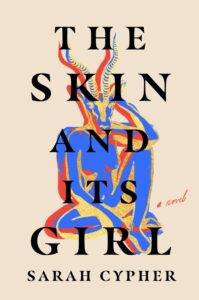 I grew up with my ankles in the Allegheny, and I come back to the city often to see my parents and poke around at Labad’s and Penn Mac. When I can, I also just walk—I love the Highland Park reservoir and the trails near Freeport. This area has so much history, and some of it feels very immediate to me. My father’s ancestry goes back to the pre–American Revolution era—basically when this was unceded Native American territory and Fort Pitt still had walls and British soldiers. My mother’s grandfather came from Greater Syria as a carpenter and then brought his family over during the height of the steel era. I spent almost my entire life in Western Pennsylvania until graduating from Carnegie Mellon in 2002, and then I moved to the West Coast. To this day, however, there might always be at least one dozen pierogies in my freezer, and a Terrible Towel somewhere in the car. You never know what you’re going to need.
I grew up with my ankles in the Allegheny, and I come back to the city often to see my parents and poke around at Labad’s and Penn Mac. When I can, I also just walk—I love the Highland Park reservoir and the trails near Freeport. This area has so much history, and some of it feels very immediate to me. My father’s ancestry goes back to the pre–American Revolution era—basically when this was unceded Native American territory and Fort Pitt still had walls and British soldiers. My mother’s grandfather came from Greater Syria as a carpenter and then brought his family over during the height of the steel era. I spent almost my entire life in Western Pennsylvania until graduating from Carnegie Mellon in 2002, and then I moved to the West Coast. To this day, however, there might always be at least one dozen pierogies in my freezer, and a Terrible Towel somewhere in the car. You never know what you’re going to need.
Where is The Skin and Its Girl set and why did you choose that setting?
My narrator Betty is narrating from Oakland, California, and grew up as a second-generation kid in the US. Her childhood was split between the Bay Area and Portland, Oregon—these were two places that felt most vivid to me at the time, since I started writing this book when I lived in Portland, and I finished it in California. Betty’s family traces its ancestry to Nablus, in the Palestinian West Bank. Her larger sense of home includes that setting too, because of the stories her great-aunt shared with her; it exists for her in this important imaginary dimension.
Where does the title The Skin and Its Girl come from?
It has a sort of funny backstory: I wasn’t sure this would be the title until very late in its publishing journey, when I saw the cover design and realized (with relief) that the book’s team decided it wasn’t too weird after all, and we could keep it. I have such a hard time with titles, and the portion of this book that was my MFA thesis will forever live in the campus library as “UNTITLED.”
I landed on The Skin and Its Girl because it captures something of how our identities are shaped by the bodies we’re born into or buttoned into by our culture, whatever that culture is. Betty’s lifetime of responding to or resisting how the world sees her eventually leaves its mark on her, and like a lot of people, she has to reckon with the irony that “what the world sees” makes its way to the inside and blurs the line between self and everything else. The story spends a lot of time with the tension between internal and external worlds: what the characters think they should or cannot be starts to affect who they actually are. The counterintuitive reversal in the title gives “skin”—the outside world—a lot of power, and the characters seek ways to accommodate or overcome that power.
Also, my narrator Betty literally has cobalt-blue skin. While I was writing, every few months someone would randomly read about the blue Fugate family in Appalachia and send me an article; and of course there is SJ Sindu’s beautiful novel, Blue-Skinned Gods. But the color blue, here, doesn’t have a clear index in American culture. It was a mysterious element that came to me early in the project and I felt I had to follow it. I like how the title holds on to that mystery.
Stories and storytelling are integral to The Skin and Its Girl. Why do you think storytelling is so important to the Rummani family?
I can say personally, storytelling was important in my family when I was growing up as a way to stay connected to a family, a place, and a culture that even my mother’s generation and most of my grandfather’s generation had lost access to. But those connections were still a kind of intergenerational memory of their life in the Old Country and then in America, especially as our relatives started to move farther away from Pittsburgh for work and marriage. Storytelling serves a similar function for the Rummani family.
But for Betty and Aunt Nuha in the novel, storytelling is also an important site of agency, a way to work through the tensions between tradition and self-discovery. For them, it’s the power to be the teller of your own tale, to subvert without directly contradicting, and also to imagine what connects us. As I wrote their characters, I was thinking about storytelling as a unique kind of language in the human species, and I drew on the rhythms of traditional Arabic folktales but played with what it would sound like if that structure were asked to carry a very different kind of material. This work felt very personal, because it parallels my own relationship to writing.
The cover is gorgeous. Talk to us about the imagery, what you wanted before you saw the finished cover and what the finished imagery is meant to evoke.
Isn’t it hypnotizing? It’s the brilliant work of Holly Ovendon. I wrote about this a bit on my Substack (https://sarahcypher.substack.com) because the process felt like magic to me. As I said there, my editor asked for five to seven other book covers I liked, just to get a sense of what look and feel appealed to me. Frequent themes were animals, bold colors, strong lines, and Yves Klein blue. I also like intricate, “fairytale-ish” designs too. When my editor, Chelcee, and I met to discuss ideas, she also displayed a piece of art she kept by her desk: a large wooden animal mask big enough to fit over someone’s head. We both recognized how much potential it had.
In terms of the final design you see, the bright cobalt color is relevant to the story. The overall image is kind of weird and physical, especially in the woman’s blue skin, nudity, and come-hither pose. It manifests the novel’s fabulist conceit of a blue-skinned narrator, and the many ways bodies assert their demands, create obstacles, and act as sites of pleasure.
And she’s also got that giant gazelle head and horns. This resonates with a motif in the novel: the gazelle as a symbol, variously, of desire, beauty, pain, and longing. The three-letter root for gazelle in Arabic is gh–z–l, and besides the animal, from this root you also get words for flirting, eulogizing, speaking about love, and spinning. It is the root of ghazal, a traditional poetic form for love poems that deal with the piercing emotional state of being separated from a beloved. The novel’s penultimate chapter is a nod to this form, except in prose.
What do you hope readers will take away from this novel?
My small, partial answer is a selfish one: this is my first published novel, and I hope readers will take away a new writer to enjoy! But truly, I hope they set down the book after the last page and feel like they’ve let these people, this big messy Rummani family, and its long history into their hearts.
I also hope there will a new connection point to Palestine. Most people who like a book might finish it and never think twice about the circumstances that inspired the story, and that’s just the reality any writer faces when they publish a book. But for some, witnessing a destructive power dynamic impels a responsibility to acknowledge it, and hopefully work towards repair. I hope more Americans will care about what’s happening right now. Nablus and the wider region is having one of its most violent years in recent memory, and it is (and continues to be) not just an over-there problem. Other realities become possible when more people gain a desire to see a change.
There’s a thread of storytelling in the novel that retells the fable of the Tower of Babel, positing a fable not just for why we humans all speak different languages but also how we live with all these painful fragmentations between us. I follow the thread in different ways through to the end, and because a certain style of storytelling can let a writer get away with being wildly optimistic, my biggest hope is that people take away a vision in which we are all humans together, even when our systems are at their most shattered. Elaine Scarry has an outstanding book on the ethical dimension of beauty, On Beauty and Being Just, and it inspired my own way of framing stories as visions of how we might build more beautiful futures with and for one another.
If you could answer just one question about this book, what would it be? And what would be your answer?
A lot of people ask, “Why blue skin?” but since we already talked about that, the other question I’d love to answer, but no one really asks, is, “Why soap?” It’s such a simple thing, but a whole history rests on it. Not all readers know the area, so it felt like it was a good entry point for writing about Palestine.
Betty describes Nabulsi soap in the book—it is this wonderfully pleasing cube derived from some core agricultural products that go back some 600 years and more: excess olive oil from the annual harvest, the ashes of the barilla plant which grew in the Jordan River valley, and the local water. If you’ve ever heard that the sourdough bread in San Francisco is good because of the water, Nabulsi soap has the same reputation. It’s a living tradition, and it’s hard to come by outside of the region. (One of the only fair-trade sources in the US is the Palestinian Soap Cooperative, https://palestiniansoap.coop.) It’s an object lesson on the life of a city and a people through time.
What are you excited to read in 2023?
I loved Isabella Hammad’s The Parisian—which I found to be full of literary gifts, including an exquisite portrayal of pre-1948 Nablus—so I’m eager to read her new novel, Enter Ghost. My TBR list is longer than it has ever been, but near the top are Lamya H’s memoir, Hijab Butch Blues and Patricia Engel’s new collection, The Faraway World. My copy of Richard Power’s The Overstory has been sitting on my nightstand like an unopened birthday present for far too long, and this summer, I just want to curl up and read about trees. Plants and their mycorrhizal networks are having a surprising moment, infiltrating the literary imagination.
What are you working on next?
Another novel, of course! In the past few years, I spent a lot of time in the Marin Headlands, those uncanny, dramatic cliffs just north of the Golden Gate Bridge. My wife was stationed near there and their wildness got me through the pandemic. I could never get over the feeling that as soon as I turned my back on the view, it might move and change on its own—and that feeling inspired the next project, which I worked on while living in one of the national park’s historic sites last summer. For as broad in scope as The Skin and Its Girl is, I am having to stretch myself to write a slender, intense little novel that I hope will resonate with curious nerds like me, people who suspect that there are better ways to think and talk about our connection to the earth if we want to save it. But every project has its own life, and we’ve only walked a little ways together so far. I hope readers will come with me too.


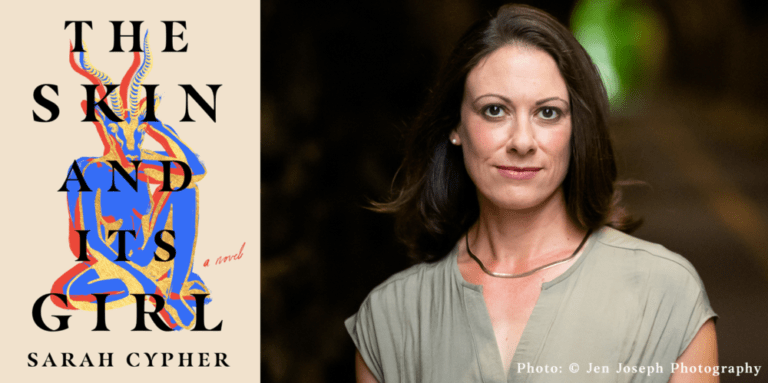




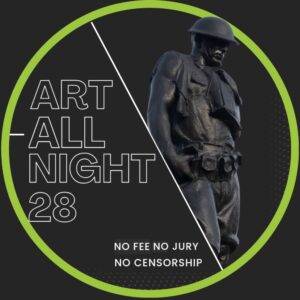

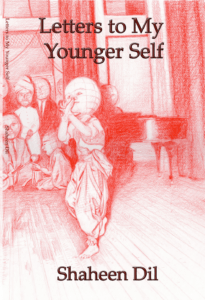
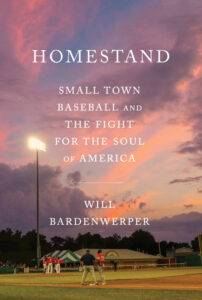


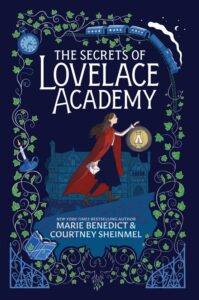
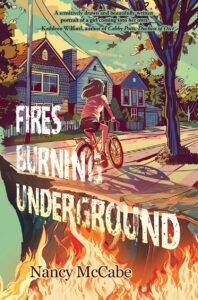

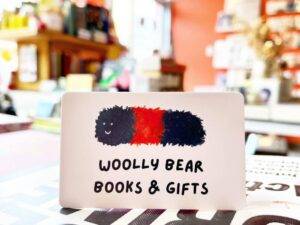




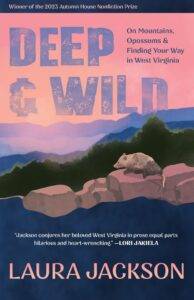
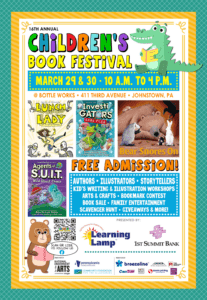
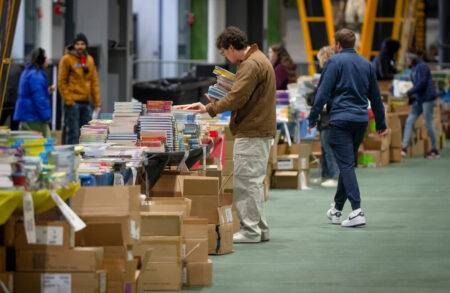

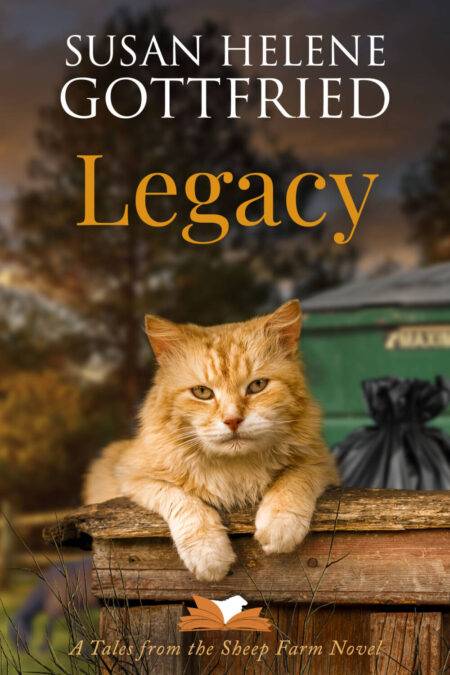
1 Comment
Pingback: Video Spotlight: Sarah Cypher (author of The Skin and Its Girl)!